You might not be aware that many baby products, even those labeled 'natural', can contain hidden chemicals that are harsh on your baby's delicate skin. As you navigate the sea of available baby care items, it's crucial to understand what goes into the products you choose. From deciphering complex ingredient lists to recognizing trustworthy certifications, each step is vital for ensuring your baby's safety and health. But how can you be sure you're truly picking the safest options? Let's explore what really matters when selecting these products, and uncover some tips that may surprise you.
Key Takeaways
- Opt for products with recognized organic certifications like USDA Organic to ensure they are free from harmful chemicals.
- Choose baby toys and accessories made from natural materials such as untreated wood and organic cotton, verified by safety certifications like ASTM or EN-71.
- Read product reviews and consult pediatric recommendations to understand the safety and suitability of baby products for specific health needs.
- Select hypoallergenic materials for clothing and bedding to minimize the risk of allergic reactions and skin irritations.
- Use plant-based cleaning products that are biodegradable and free from harsh chemicals to maintain a safe and healthy environment.
Understand Ingredient Labels
When choosing baby products, it's essential to look beyond the bright packaging and delve into the ingredient labels. You're not just shopping for a product; you're ensuring the wellbeing of a child. Understanding ingredient sourcing and label transparency is paramount.
Firstly, examine where the ingredients come from. Products sourced from reputable suppliers who adhere to strict quality control and ethical standards are typically safer and purer. Ask yourself, are these ingredients sustainably sourced? The answer can often be found directly on the label or the manufacturer's website.
Label transparency is equally crucial. A transparent label isn't just a list of ingredients but a clear, honest declaration of what's inside the bottle. It should provide comprehensive information, including any allergens or potential irritants. This transparency empowers you to make informed decisions aligned with your desire to care for and protect.
Lastly, remember that not all ingredients with complex names are harmful, and not all natural ingredients are safe. It's about the safety and suitability of these ingredients in baby products.
Always cross-reference the ingredients with trusted sources to understand their functions and potential effects on health. Choose wisely, as you hold the responsibility of nurturing a young life.
Avoid Harmful Chemicals
You should be vigilant in avoiding harmful chemicals commonly found in baby products. Reducing chemical exposure is crucial for the health and safety of your little one. Here's a helpful table listing some common harmful chemicals and their safe alternatives:
| Harmful Chemical | Safe Alternative |
|---|---|
| Phthalates | Natural essential oils |
| Parabens | Vitamin E (natural preservative) |
| Formaldehyde | Plant-based preservatives |
| Sodium Lauryl Sulfate | Coconut-derived surfactants |
| Synthetic fragrances | Natural fruit and flower extracts |
When selecting products, it's essential to scrutinize labels and opt for those with clear, understandable ingredients. Many chemicals linked to adverse health effects can lurk under the guise of complex scientific names. Opting for products with fewer and more recognizable ingredients can significantly reduce the risk of unintended chemical exposure.
Always research brands committed to transparency and safety in their formulations. By opting for safe alternatives, you're not only protecting your baby but also contributing to a healthier environment. Remember, a little extra diligence now ensures well-being in the long run.
Look for Organic Certifications
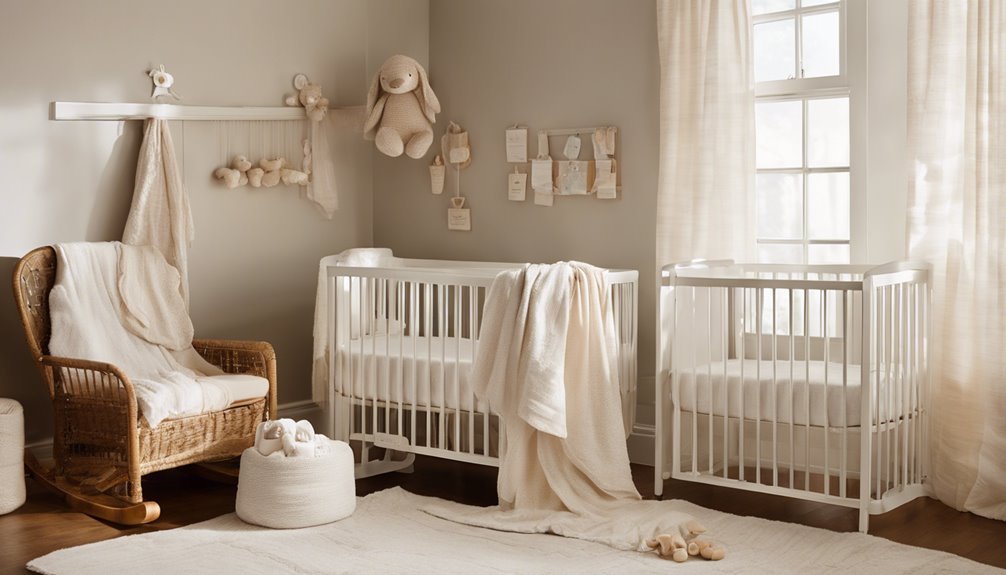
Continuing with the theme of safeguarding your baby's health, seeking out organic certifications on baby products provides an additional layer of safety.
It's crucial you understand the significance of these certifications. They aren't just labels but are assurances from certification bodies that the products meet stringent organic standards. These standards are meticulously designed to ensure that everything from the ingredients to the manufacturing processes adheres to strict guidelines regarding environmental impact and toxin exposure.
When you're choosing products like baby lotions, shampoos, or clothing, check for marks from recognized organic certification bodies. These might include USDA Organic, EcoCert, or others depending on your location. Each of these bodies has its criteria, but all aim to limit your baby's exposure to harmful chemicals that can be avoided.
It's vital to delve into what these standards cover. They typically ensure that no harmful pesticides, artificial colors, or genetically modified organisms are in organic products.
This careful regulation helps protect not just the environment but also your baby's delicate health. By choosing products with these certifications, you're taking a proactive step in minimizing the risk of allergies and other health issues, giving you peace of mind.
Choose Fragrance-Free Options
Opting for fragrance-free products can significantly reduce your baby's risk of skin irritation and allergies. When you're selecting skincare or cleaning items for your child, understanding the role of fragrance sources is crucial. Many products boast a "fresh" or "clean" smell, derived from a mix of chemicals that can trigger scent sensitivity in young children. These sensitivities aren't only uncomfortable but can also lead to longer-term health issues.
It's important to scrutinize labels for terms like "unscented" or "fragrance-free." Beware, as "unscented" might still contain masking fragrances designed to neutralize other smells. Truly fragrance-free products won't contain any synthetic scents and are your safest bet for avoiding potential irritants.
Remember, babies have delicate skin and a developing immune system, making them more vulnerable to harsh chemicals found in many scented products. By choosing items that sidestep artificial fragrances, you're not only safeguarding their skin but also fostering a healthier environment for their overall development.
Always consult product ingredient lists and opt for those with simple, recognizable components. Serving the needs of your baby with such mindful choices ensures they're exposed to only the gentlest, safest products.
Consider Eco-Friendly Packaging
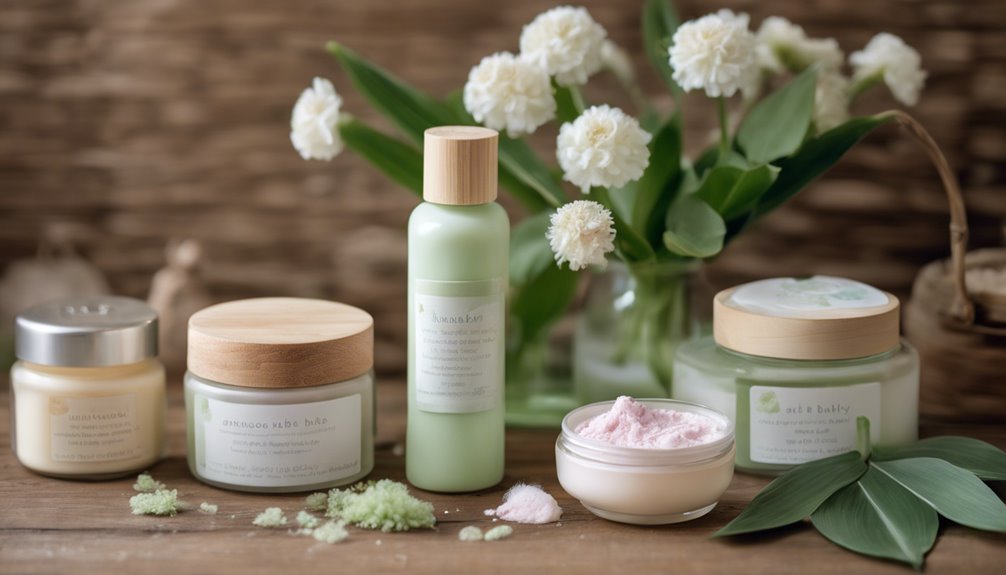
Selecting eco-friendly packaging for your baby's products contributes to both environmental sustainability and your child's health.
By opting for sustainable materials and biodegradable options, you're not only reducing environmental impact but also minimizing your baby's exposure to potentially harmful substances often found in conventional packaging materials.
Here are three key points to consider when choosing eco-friendly packaging:
- Verify the Materials: Look for packaging made from sustainable materials such as recycled paper, bamboo, or bioplastics. These materials are generally safer for the environment and, by extension, for your family.
- Check for Biodegradability: Ensure that the packaging isn't only recyclable but also biodegradable. This means that the materials will naturally decompose, leaving minimal environmental footprint. Biodegradable options are crucial in reducing the accumulation of waste in landfills.
- Assess the Manufacturing Process: It's important to consider how the packaging is produced. Opt for products packaged with minimal environmental impact, such as those using renewable energy sources and water-saving technologies.
Research Product Reviews
After considering the sustainability of your baby products' packaging, you should also evaluate the effectiveness and safety of the products themselves by researching various reviews. It's crucial to delve into product comparisons and review compliance with safety standards. This not only helps you make informed decisions but also ensures that you are providing the safest options for those in your care.
Product reviews can be a goldmine of information. They often reveal the experiences of other parents with the product, focusing on aspects like safety, durability, and ease of use. Look for reviews that specifically address the product's adherence to safety standards, as these are critical for your baby's well-being.
To aid your research, here's a structured comparison:
| Product | Key Safety Feature |
|---|---|
| Product A | BPA-free materials |
| Product B | Rigorous safety tests |
| Product C | Organic components |
| Product D | Non-toxic finishes |
Gather data from various sources to ensure a wide range of opinions and experiences. Remember, your aim is to protect and nurture, making the health and safety of the products you choose paramount.
Prioritize Hypoallergenic Materials
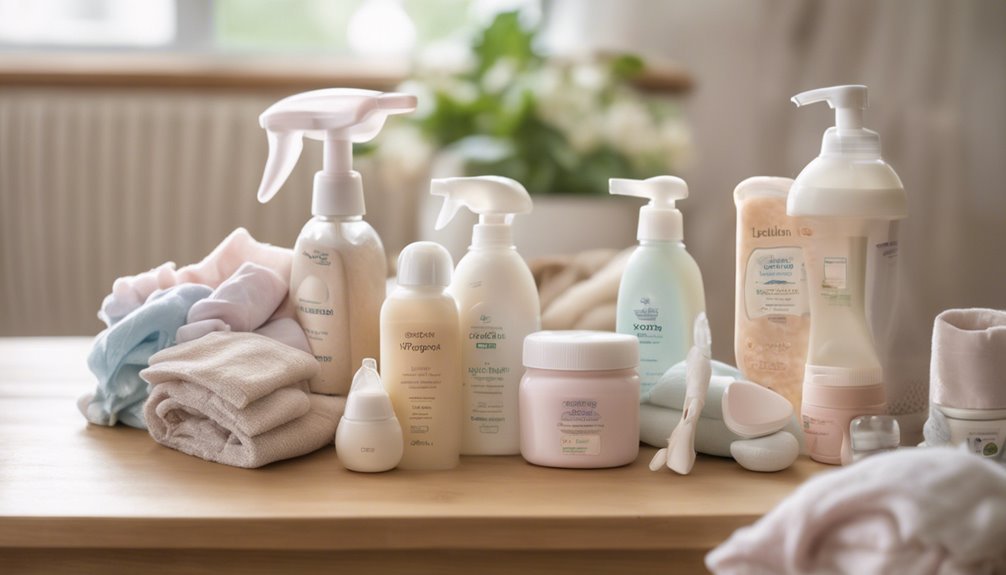
Frequently, parents overlook the importance of hypoallergenic materials when selecting baby products, yet these materials are crucial for minimizing the risk of allergies and skin irritations.
As you choose products that come into direct contact with your baby's skin, it's essential to prioritize hypoallergenic fabrics to safeguard their vulnerable skin against potential irritants.
Here's what you need to consider:
1. Identify Hypoallergenic Labels: Look for products specifically labeled as hypoallergenic. These have been designed to reduce the likelihood of triggering an allergic reaction, which is particularly important for infants with sensitive skin.
2. Understand the Materials: Not all materials claiming to be gentle are suitable. Research the components of hypoallergenic fabrics to ensure they don't contain allergens common in baby products.
It's not just about avoiding harm; it's about ensuring comfort and health.
3. Consult Healthcare Providers: If your baby has shown signs of skin sensitivity, consult with a pediatrician or dermatologist. They can recommend specific hypoallergenic products tailored to meet your baby's unique needs.
Explore Natural Fiber Clothing
Exploring the realm of natural fiber clothing offers a viable solution for parents seeking safer, softer alternatives for their baby's wardrobe. As you consider various materials, it's essential to prioritize fibers like organic cotton and bamboo fabric. These options not only ensure comfort for your child but also promote a healthier environment due to their sustainable and pesticide-free cultivation methods.
Organic cotton is renowned for its softness and breathability, making it an ideal choice for your baby's sensitive skin. This material avoids the harsh chemicals found in conventional cotton, reducing the risk of allergies and skin irritations.
Similarly, bamboo fabric offers a naturally hypoallergenic quality with excellent moisture-wicking properties, keeping your baby dry and comfortable.
When selecting these garments, it's crucial to verify the authenticity of the materials. Look for certifications such as Global Organic Textile Standard (GOTS), which confirms the organic status of textiles from the harvesting of the raw materials through environmentally and socially responsible manufacturing.
Select Non-Toxic Toys
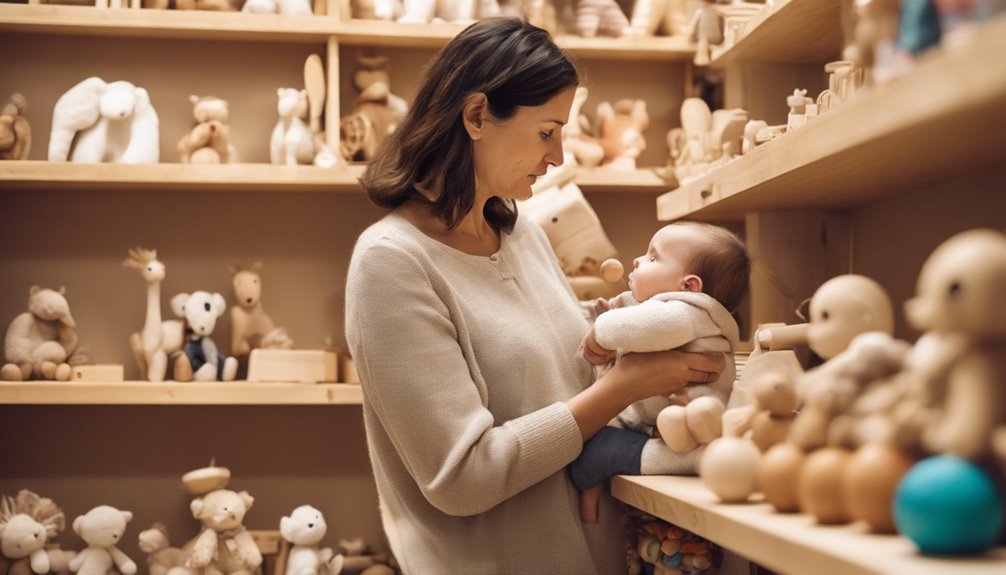
Selecting non-toxic toys is crucial for safeguarding your baby's health and development. As you navigate the vast market of baby toys, it's important to focus on those that offer both safety and developmental benefits.
Toys aren't just playthings; they're instrumental in your child's early learning and sensory stimulation. Here's how you can ensure the toys you choose are safe and beneficial:
- Check for Certifications: Look for toys that have certifications indicating they're free of harmful chemicals and toxins. Certifications like ASTM, EN-71, or CE mark signify that the toy meets stringent safety standards.
- Opt for Natural Materials: Prioritize toys made from natural materials such as untreated wood, organic cotton, or natural rubber. These materials aren't only safer but also promote sustainable sourcing, which is better for the environment.
- Research Developmental Benefits: Select toys that support different aspects of development, such as motor skills, cognitive abilities, and emotional growth. Ensure the toys are age-appropriate to provide your child with the right challenges and stimulation.
Use Plant-Based Cleaning Products
Switching to plant-based cleaning products is a prudent choice for maintaining a safe and healthy environment for your baby. These products often contain fewer harsh chemicals, reducing the risk of exposing your child to potentially harmful substances that can linger on surfaces or become airborne.
The plant-based benefits extend beyond safety, as these cleaners are typically biodegradable and less damaging to the environment compared to their synthetic counterparts.
Furthermore, you might question the cleaning effectiveness of these natural options. Rest assured, many plant-based cleaners have proven equally, if not more, effective at eliminating germs and bacteria as traditional cleaning agents. Brands that focus on natural cleaning solutions often rigorously test their products to ensure they meet high standards of purity and efficacy.
When you choose these products, you're not just protecting your child but also contributing to a larger cause of environmental stewardship. It's a responsible step that aligns with a caring approach towards future generations.
Always check for certifications and read labels carefully to ensure the products are free from hidden synthetics and are truly derived from natural sources. This diligence ensures you're genuinely enhancing your baby's living space with safe, natural alternatives.
Consult Pediatric Recommendations
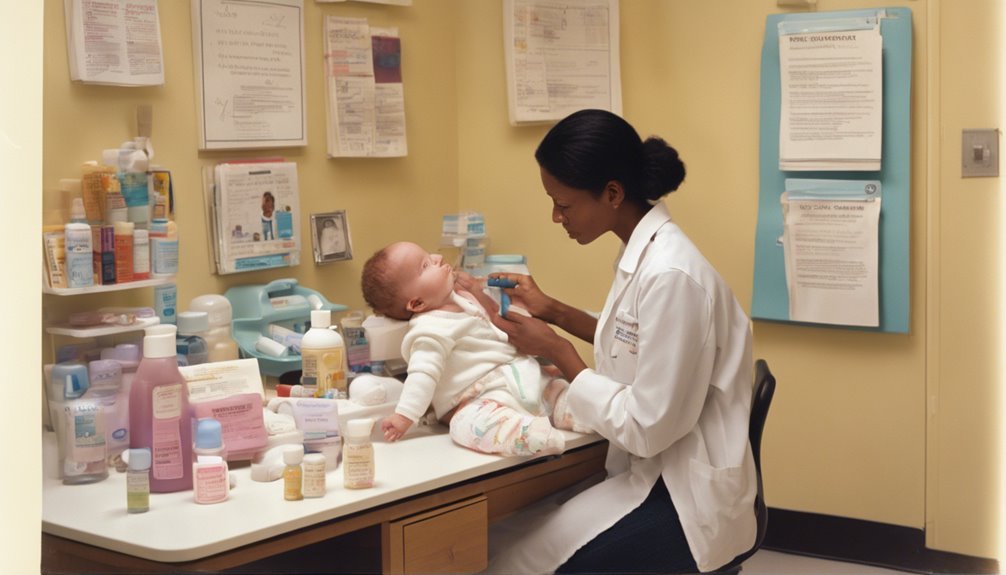
While considering which baby products to use, it's crucial to consult pediatric recommendations to ensure the safety and suitability of these items for your child's specific needs.
Pediatricians, with their profound understanding of child health, offer invaluable insights that can guide you in making informed choices.
Pediatric guidelines often emphasize the importance of avoiding products with harmful chemicals and allergens that can affect your baby's delicate skin and overall health.
Seeking medical advice becomes particularly essential if your child has existing health conditions or sensitivities.
Here's how you can effectively consult with healthcare professionals:
- Prepare a List of Products: Before your consultation, prepare a detailed list of the products you're considering. Include ingredients and brand names.
- Discuss Potential Risks: Ask about any known risks associated with these products. Pediatricians can provide insights based on the latest research and safety data.
- Seek Recommendations: Request specific product suggestions that align with medical advice. Pediatricians can recommend brands or product types that are known for their safety and efficacy.
Monitor Baby's Reactions
After consulting with pediatricians and choosing baby products that align with their recommendations, it's important to closely observe how your baby reacts to these products.
Monitoring your baby's behavior and any signs of skin sensitivity is crucial in determining whether a product suits their delicate condition.
Notice changes in your baby's mood or health. Any unusual fussiness or discomfort could be a sign of an adverse reaction. Keep an eye on their skin after using a new product. Look for any signs of irritation, such as redness, bumps, or dryness, which might suggest skin sensitivity.
It's also wise to introduce one product at a time; this way, if there's a reaction, you'll know exactly which product caused it.
You should document your observations to discuss with your pediatrician during visits. This record-keeping will help in identifying patterns in baby behavior and any correlations with specific products.
If you notice any negative reactions, stop using the product immediately and consult your pediatrician for advice.
Your vigilance in monitoring these reactions not only helps in maintaining your baby's health but also ensures that their care is always tailored to their specific needs.
Frequently Asked Questions
How Often Should I Replace Natural Baby Products?
You should replace natural baby products according to the frequency guidelines provided by manufacturers, as product shelf life varies.
Typically, items like creams or lotions should be replaced every six to twelve months, while durable goods might last longer.
Always check expiration dates and monitor the condition of products regularly.
Ensuring the items you use are in good condition is crucial for maintaining your baby's health and safety.
Can Natural Products Cause Allergies in Babies?
Yes, natural products can cause allergies in babies. About 10% of children have a reaction to at least one allergen.
It's crucial to monitor allergy symptoms and read ingredient labels carefully. Look for common irritants like fragrances or certain plant extracts.
Always patch-test products before full use to ensure your baby's safety. Your vigilance helps protect those most vulnerable, guiding you to make informed, caring choices in their daily care.
What Are the Best Storage Practices for Organic Baby Products?
To ensure the safety of organic baby products, you should store them in airtight storage containers and keep them in a cool, dry place.
This practice helps maintain the product's integrity and extends its shelf life. Always check expiration dates and observe any changes in texture or smell.
Proper storage is crucial in preventing the degradation of natural ingredients, which can compromise their effectiveness and safety for your baby's use.
Are There Natural Baby Products for Sensitive Skin?
Yes, there are natural baby products specifically designed for sensitive skin.
You'll want to look for items that highlight natural ingredients and sensitive formulations in their descriptions. These products typically avoid harsh chemicals, perfumes, and dyes, which can irritate delicate skin.
Opt for hypoallergenic labels and consider patch-testing a small area first to ensure it's gentle enough.
Always prioritize your baby's safety and comfort when selecting these products.
How Do Natural and Synthetic Baby Products Differ in Cost?
When comparing the costs of natural versus synthetic baby products, you'll find that natural options often carry a higher price tag.
This price difference is due to the sourcing of organic materials and less chemical-intensive production methods.
A thorough cost analysis shows that while you might pay more upfront for natural products, the benefits to your baby's health and well-being could lead to potential long-term savings in healthcare expenses.
Conclusion
As you navigate the maze of baby products, juxtapose your child's delicate health against the plethora of options. Choose wisely: opt for items with transparent, organic certifications, and shun those with obscure chemicals. Engage with eco-friendly packaging and non-toxic toys to safeguard your baby's health while nurturing the environment. Always consult your pediatrician and attentively monitor your baby's responses to new products. Informed choices today pave the way for a healthier, more sustainable tomorrow.




